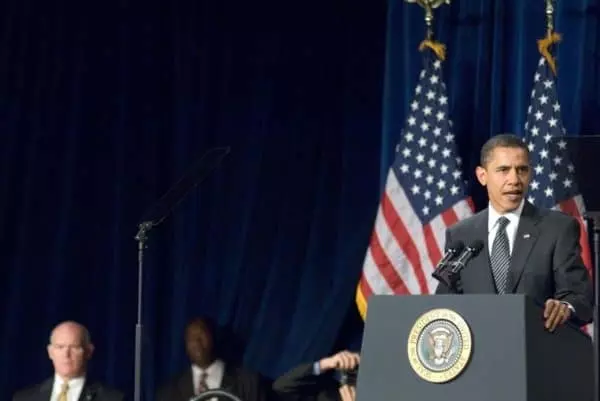
This morning, President Obama signed the historic Frank R. Lautenberg Chemical Safety for the 21st Century Act, potentially creating a path to a full ban on asbestos – and other toxic chemicals – in the United States.
The act passed the House of Representatives near the end of May and then passed in the Senate earlier this month, despite a delay due to objections raised by Kentucky Republican Senator Rand Paul. Once the Senate passage was confirmed, however, it was only a matter of time until the bill would become law. The President had previously indicated that he would sign the law, a position reiterated by Press Secretary Josh Earnest during a press briefing.
“Look, we believe that this is a rare moment of bipartisanship in Congress,” Earnest stated on June 8, “and we are pleased to see that the Environmental Protection Agency has been given additional authority to ensure that we can keep our families safe. And preventing these kinds of toxic chemicals from being used in a harmful way in consumer products will make our homes and communities safer. And we obviously give Democrats and Republicans in Congress credit for working together to approve this bill. The President will sign it, and we’ll let you know when he has.”
Today, that signing occurred.
Key Supporters Invited to Signing Ceremony
A number of supporters of the bill were invited to the signing ceremony, which occurred at 11:15 this morning in the South Court Auditorium. These included Bonnie Lautenberg – widow of the bill’s namesake, former Senator Frank R. Lautenberg – as well as many members of Congress who sponsored or supported the bill, regulators such as industry representatives from the American Chemical Council and SC Johnson, and organizations like the March of Dimes and Environmental Defense Fund that pushed for the legislation to be passed.
One of the groups invited was the Asbestos Disease Awareness Organization (ADAO). The ADAO, an organization that promotes awareness about the dangers of asbestos, played a critical role in making sure that asbestos was one of the substances that could be reviewed by the Environmental Protection Agency (EPA) under the new policies and procedures created by the law.
“Receiving this invitation is proof that the voices of asbestos victims were heard in the drafting of this momentous legislation,” wrote ADAO President and Co-Founder Linda Reinstein in a post on the organization’s blog, “and it is my great honor to attend this momentous occasion on behalf of the ADAO community.”
In her blog post, Reinstein reiterated that the Lautenberg Act is not perfect, saying, “I call it a compromise bill – but it removes some of the major obstacles that weakened the EPA’s power to ban asbestos. It is a step in the right direction, and ADAO will continue to be a stakeholder at the table pushing for an expedited full ban on asbestos.”
However, Reinstein recognized the momentousness of this opportunity to reflect on the accomplishments the ADAO and other supporters of Lautenberg Act have achieved so far. “This victory truly belongs to all of us, and from the bottom of my heart, thank you for the hard work and dedication you showed in the process of bringing about this historic policy reform.”
Lautenberg Act Another Step in Protecting Our People and Environment
During his speech at the signing, President Obama reviewed the legislative history of laws that attempted to regulate toxic chemicals, noting early attempts that helped clean up waterways in his home city of Chicago, leading up to the Toxic Substances Control Act (TSCA), signed in the 1970s. The signing of the Lautenberg Act also marked a historic moment in environmental law, as the last major environmental protection law was signed twenty years ago.
“For the first time in 20 years, we’re updating a national environmental statute.” —@POTUS on #ChemicalSafety reform
— The White House (@WhiteHouse) June 22, 2016
However, the President focused on the limitations of these previous laws. The Lautenberg Act, he said, would overcome many of the problems of formerly passed legislation, allowing the EPA to act on bans that previously were unable to be passed.
“Even with the best of intentions, the [TSCA] did not quite work the way that it should have in practice,” the President acknowledged, noting that the restrictions placed on the EPA were so onerous that it became virtually impossible to understand whether most chemicals were harmful.
“The system was so complex, it was so burdensome, that our country hasn’t even been able to uphold a ban on asbestos, a known carcinogen that kills as many as 10,000 Americans every year,” the President said, calling out asbestos specifically. “I think a lot of Americans would be shocked by that.
“For the first time in our history,” the President stated, “we’ll actually be able to regulate chemicals effectively.”
According to the President, the new law “will make it easier for the EPA to review chemicals already on the market, as well as the new chemicals our scientists and our businesses design. It will do away with an outdated bureaucratic formula to evaluate safety, and instead will focus solely on the risks to our health.” It will also grant EPA scientists and researchers funding to accomplish the ultimate goal of keeping everyone safe.
“This is a good law, an important law,” President Obama concluded.
After his speech, the President signed the law to the applause of all who attended.

A Rare Moment of Bipartisanship
During his speech, President Obama praised the cooperation between political parties, industry groups, and organizations who all came together to create this complex bill.
The Lautenberg Act, said the President, is being passed “in the same overwhelmingly bipartisan fashion as happened with those pillars of legislation that protect our air, and our water, and our wildlife – the initiatives where the Democrats and the Republicans first came together to pass [environmental] laws more than four decades ago.”
The President added that such bipartisanship is rare these days, a situation that gives even greater weight to the passage of the Lautenberg Chemical Safety Act.
Whether this bipartisan attitude towards keeping everybody safe from toxic substances continues remains to be seen. There is still a long ways to go before a full ban on asbestos and other dangerous materials could be implemented, and there may be many years of rulemaking, policy drafting, and even court hearings that could delay and interrupt the process.
For the time being, though, hopes are high.



